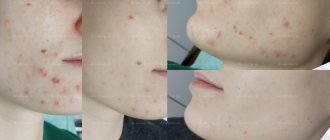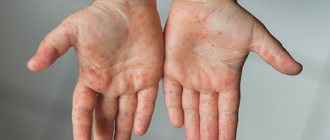Services Doctors Results Reviews
Expert tested
Trichologist, dermatovenerologist, cosmetologist
Publication date: October 10, 2022
Review date: November 16, 2022
Although on average there are about 140 thousand hairs on the head, the norm for daily natural hair loss is considered to be from 50 to 100 hairs. Of course, none of us will count the hairs remaining on the brush, but if visually there are a lot of them left after combing, you need to urgently take action - start professional treatment with a trichologist.
There are several types of hair and scalp problems:
- hair loss (alopecia);
- the appearance of dandruff and seborrhea;
- degeneration of hair shafts (breakage, thinning of hair, appearance of split ends);
- fungal infections.
Why do my hair and scalp hurt?
Even if your hair begins to noticeably fall out, you should not immediately panic and assume that this is a consequence of some serious illness.
As a rule, hair problems begin due to frequent stressful situations, poor environment, unbalanced diet, hormonal imbalance in the body, various infections or too much enthusiasm for hair cosmetics, as well as various dyes or chemicals for curling or straightening.
Sharubina Karina Petrovna
Trichologist, dermatovenerologist, cosmetologist
With nervous exhaustion, overwork, and depression, hair becomes brittle and dry, and dandruff appears. Dryness is caused by decreased function of the sweat and sebaceous glands. Hair also becomes brittle and dry due to decreased levels of hormones in the blood and poor nutrition. Severe stress can affect the development of “focal” (“cluster”) baldness, when round-shaped areas devoid of hair appear on the skin.
Hair can also fall out in clumps when the body is intoxicated. But increased oiliness of hair is caused by the use of large amounts of fatty nourishing oils and masks.
In what cases should you contact a trichologist?
- Increased hair loss began
- Hair began to thin
- Areas of baldness have appeared on any part of the skin
- Crusts, ulcers, and pustules appeared on the scalp
- There is an itch
- Dandruff appears
- Early gray hair appeared
- Hair has lost elasticity, shine, strength
- The structure of the hair shaft has changed (it has become thinner, more brittle...)
- Desire to strengthen and prevent hair loss/thinning
What scalp diseases lead to hair loss?
Seborrhea
(peeling) appears due to dysfunction of the sebaceous glands. With oily seborrhea, the sebaceous glands are overactive; with dry seborrhea, on the contrary, skin sensitivity is observed. In both cases, seborrhea is accompanied by dandruff and itching.
Furunculosis
- inflammation of the hair follicles and sebaceous glands - is caused by staphylococcus bacteria, which can penetrate the scalp through microcracks.
Mycosis
- fungal disease. It is accompanied by itching, the formation of pustules, and darkening of the scalp. With mycosis, areas of baldness appear on the head.
Alopecia
(baldness) occurs due to various reasons, which can be divided into two types: external (frequent stress, infectious diseases, trauma and damage to the surface of the head); internal (hormonal imbalances, metabolic disorders, predisposition at the gene level (heredity).
Main features
The symptoms of seborrheic alopecia are similar to those of seborrhea, since both diseases are caused by a malfunction of the sebaceous glands. The main features include:
- unpleasant odor;
- rapid loss of freshness and cleanliness of hair after washing;
- thickened layer of keratinized skin;
- presence of inflammation.
Increased activity of the sebaceous glands leads to the appearance of excess oil on the skin. Sebaceous ducts and hair follicles become clogged. Horny particles accumulate on the scalp, face, and body. They stick together and form a viscous mass. This environment is good for fungal growth. The parasite becomes active, attacks the hair follicles, the hair becomes weak and begins to fall out.
There are three main types of seborrhea: dry, oily and mixed. Alopecia occurs with oily skin.
Message sent!
Features of hair loss in men
Male pattern baldness is called androgenetic or androgenetic. It also occurs in women, but is quite rare.
Androgenetic type of baldness is caused by hormonal imbalances in the body. Moreover, in men, loss is associated not so much with a drop in testosterone levels, but with its active metabolite - dihydrotestosterone. It is released (under the action of an enzyme) in the follicle, causing premature hair loss.
The cause of baldness may also be a genetic predisposition.
This type of baldness is localized in the frontoparietal and vertex regions. The temporal and occipital areas are practically not affected.
Androgenic type of baldness appears gradually. The process, as a rule, begins with the hair thinning, becoming brittle, and growing more slowly. Then bald patches begin to appear. In representatives of the stronger sex, they are located on the crown or frontal areas.
In addition, the process of hair loss on the head is often accompanied by increased growth of facial hair, the appearance of acne and oily seborrhea.
If you do not start timely treatment for hair loss, it will be extremely difficult to stop baldness: hair will begin to quickly fall out both in the frontoparietal and vertex areas.
Methods of therapy
With seborrheic dermatitis, hair can fall out both on the entire surface of the head and in certain areas (on the back of the head, temples, frontal part). It is better to prevent the problem from developing; it is very important to intervene at an early stage. The treatment is simple. However, the process is very lengthy and requires patience, an integrated approach and consistency. Work is being carried out in a number of areas:
- organization of proper nutrition;
- use of special hair care products;
- physiotherapy;
- drug treatment.
Features of hair loss in women
Female pattern baldness is called diffuse or uniform. Hair loss in women occurs all over the head. And it starts from the vertex and frontoparietal zones.
At the same time, hair loss in women does not create bald patches - the front hairline is preserved. If you don’t start treatment after your hair starts to fall out rapidly, then in a couple of years it will thin out very much all over your head. And after 10-15 years, without proper therapy, complete hair loss can occur.
Hair loss in women can occur either actively or gradually.
Hair loss in a woman can be: telogen effluvium (the most common type, the cause of which is that 80% of follicles (hair follicles) go into “dormant form” ahead of schedule due to chronic diseases or damage to the endocrine system); anagen form (this type of hair loss occurs due to exposure to aggressive environmental factors, and the follicles may completely die).
Other common causes of hair loss in women include: hormonal imbalance; postpartum period; toxic effects; iron deficiency; exposure to fungi or microbes; problems with immunity; frequent dyeing, perm.
Spectral analysis for diagnosing hair condition
This is a study whose purpose is to determine the concentration of trace elements in hair. Throughout the entire period of growth, they accumulate and retain information about metabolism.
Therefore, using spectral analysis, it is possible to determine the deficiency or excess of certain microelements not only in the hair, but throughout the body. After all, if there is a lack of specific minerals in the hair, then there are not enough of them in the blood.
To do this, take several strands of hair from the back of the head, up to 1 cm wide and 3-4 cm long. Typically, the study includes the determination of 25 basic microelements. There is an extended spectral analysis with the determination of 25 main and 15 additional (this includes toxic elements) minerals. Based on the results of the study, an individual program is drawn up to replenish missing elements and correct mineral metabolism.
Why Absolut Med Clinic
- For our work, we use only proven, modern, effective equipment;
- You are served by professionals with many years of experience, higher education, who take part in scientific conferences, conduct seminars and master classes in Moscow and foreign countries.
Hair loss treatment
Before starting therapy, it is important to identify the exact cause of baldness.
Baldness treatment
selected individually based on diagnostic results. The sooner therapy is started, the higher its effectiveness will be.
Hair and scalp are treated using special procedures and drug therapy, which includes drugs aimed at reducing the sensitivity of the follicles and restoring them.
Proper balanced nutrition, which includes all the necessary vitamins and microelements, is also important.
Among the most effective procedures are the following.
Plasma therapy (PRP therapy)
Shown
: For hair loss, dry and oily seborrhea, fungal infections of the scalp, thinning hair, dull color, increased hair fragility.
The method is similar to Mesotherapy
, only the injectable drug is not therapeutic cocktails, but platelets, which are obtained from a small amount of blood taken from the patient.
The resulting concentrate contains 4-5 times more platelets compared to the starting material taken from the patient. It is injected into areas of the scalp where hair loss is noticeable. The administered drug begins to work instantly. Penetrating into the skin, blood cells - platelets - begin to have a strengthening effect. After this procedure, the hair follicles begin their work with renewed vigor, which leads to active hair growth. When treating baldness, the main thing, as you know, is not to miss the moment when the hair follicle itself is still alive, since new hair grows from the same follicle as the old one. Therefore, PRP therapy
recommended for patients who have begun to lose hair or have encountered the problem of alopecia relatively recently.
The procedure activates the mechanism of intercellular metabolism, enhances the synthesis of useful substances, which is why the hair becomes thicker and stronger within a few weeks. In addition, PRP therapy helps eliminate dandruff and perfectly relieves inflammation. As a result of treatment, hair acquires a healthy shine, becomes more elastic, thicker, and its structure is restored. Hair stops splitting.
Placental therapy
Shown
: For hair loss. To enhance their growth.
Preparations based on the hydrolyzate of human placenta (primarily Japanese Laennec), which are administered intravenously, intradermally, at biologically active points, stop hair loss and activate their growth. The hair on the placenta is alive and shiny.
In addition, Placental therapy is a complex effect on the body. After all, the condition of the hair is a reflection of the internal processes occurring in the body.
Unlike most modern medicines, Laennec has a therapeutic effect without causing side effects or causing harm to the body. Such drugs are called “smart” or “intelligent”, since they themselves find disturbances, as well as points of imbalance, and have an optimal targeted effect to restore balance and optimize the parts of the body system.
The drug contains more than 50 water-soluble components, including: 18 amino acids; mucopolysaccharides necessary for the construction of connective tissues; nucleic and organic acids, nucleosides that enhance protein biosynthesis; vitamins B2, B3, C, D, PP, which provide the antioxidant effect of the drug and are catalysts for metabolic processes; minerals (zinc, magnesium, iron, manganese, copper, selenium, etc.), which are involved in the construction of the skeleton and the formation of hemoglobin, regulate the exchange of vitamins and hormones; Pohormone DHEA is the ancestor of the missing hormone at the physiological level - progesterone, estrogens or testosterone.
The components of the drug Laennec introduced into the scalp penetrate into the foci of pathology and eliminate them, restoring the immune system and mobilizing the body's defenses.
Mesotherapy
Shown
: Prevents hair loss and improves its general condition, helps fight premature gray hair.
Special therapeutic cocktails are injected into the scalp. In other words, there is a direct delivery of medicinal drugs directly to the hair follicle. The cocktails contain various substances that nourish the hair follicle, improve its blood supply and oxygen supply.
Most often, cocktails consist of zinc, selenium, vitamin B, and amino acids. Vitamin B helps get rid of dandruff, strengthens the hair follicle and normalizes the functioning of the sebaceous glands.
Zinc and selenium play an important role in skin regeneration processes and promote hair growth. All these substances beneficial to the body help stop the process of graying and restore the natural color of the hair.
In addition, the injection itself matters. Because the area between the upper and middle layers of the skin, where the germ cells are located, is mechanically irritated. They are encouraged to be active.
One of the causes of hair loss is poor blood supply to the cervical spine. Because of this, hair follicles receive insufficient amounts of vitamins, microelements, and oxygen. Therefore, if the patient is already experiencing loss or this process is just beginning, mesotherapy cocktails are administered not only to the scalp, but also to the cervical-collar area.
Mesotherapy
normalizes blood microcirculation. Blood supply in the cervical spine is normalized.
Microcurrent therapy
Shown
: With hair loss, deterioration of its structure, which leads to the thinning of each hair shaft. Suitable for reducing oily scalp.
The essence of the method is that the scalp is exposed to pulsed currents of low frequency. To carry out Microcurrent therapy, Biogenie Capillaire is used - a fundamentally new device developed by the Rene Bouchaud laboratory (the French company founded by Jaqui Bouchaud uses unique developments, all the most advanced that scientists can offer today) for biotherapy. The potential of Biogenie currents, corresponding to the potential of the cell membrane, in combination with individually selected cosmetics, perfectly promotes the growth of the hair follicle.
It is thanks to the low frequency of pulses that microcurrents penetrate deep into the layer of the epidermis, promoting the dilation of blood vessels, improving blood flow, lymph flow, nourishing the skin with oxygen, and activating metabolic processes in the hair follicles. As a result, hair begins to grow faster, acquires a healthy shine and well-groomed appearance. Weak, damaged hair is restored, the secretion of the sebaceous glands is normalized.
Microcurrents, stimulating the metabolic processes of the scalp, promote the removal of harmful substances from the body, tissue regeneration, and a general improvement in hair condition. In addition, the “sleeping” bulbs are awakened.
Microcurrent therapy
– a painless procedure. It is carried out either in areas that are affected by a particular disease, or over the entire surface of the head.
The procedure is very comfortable for the patient and causes only pleasant sensations. It is especially loved by men who, unlike women, tolerate injection techniques worse.
After just one procedure, hair loss is reduced. After the procedure, the hair looks more vibrant and healthy. The scalp begins to breathe.
Laser therapy
Shown
: For diseases of the scalp - psoriasis, atopic dermatitis, neurodermatitis, dysfunction of the sebaceous glands (dryness, oiliness, dandruff). Hair after laser exposure becomes more elastic, dense, and manageable.
Low Level Laser Therapy
approved by the US Food and Drug Administration.
A low-frequency pulsating light beam penetrates deep under the surface of the skin to the very hair roots - to a depth of 6-8 mm. The energy generated by laser radiation increases the level of blood circulation in the scalp, supplying it with oxygen and increasing the level of metabolism in cells.
At the same time, approximately 70% of hair moves from the resting phase to the growth phase. As a result, 90% of patients stop losing hair, and 50% experience significant hair growth. During therapy, the quality of thinning hair also changes: it thickens and acquires a healthy shine. Renewing blood flow can also be a means of solving problems such as itching, dandruff, hypersecretion of the sebaceous glands, which are also causes of hair loss.
Types of hyperkeratosis
Hyperkeratosis can be hereditary or acquired. Depending on the clinical manifestations, the disease is divided into the following types:
- follicular (lichen pilaris, appears more often in childhood on the scalp);
- lenticular (mainly on the skin of the extremities, thighs, ears);
- diffuse (more often appears in childhood on the extensor surface of the arms and legs, on the back);
- seborrheic (affects the scalp);
- disseminated (distributed over the entire surface of the skin);
- warty (single lesion on an open area of the body).
Dermatologists tend to call hyperkeratosis not an independent disease, but a consequence of systemic disorders, so treatment of the scalp and other areas should not be symptomatic, but comprehensive.
When should I expect results from treatment with a trichologist?
You'll have to be patient. The minimum period for the effect of treatment to appear is 3 months. This is due to the anatomical and physiological characteristics of hair. At the time of treatment, a certain part of the follicles is occupied by dead hair, and despite even the most intensive measures of influence, the period of release of the follicles from all dead hair remains unchanged; they will leave the follicles for 2-3 months. In practice, this means that you are being treated, but complaints about hair loss persist.
It is necessary to understand that the treatment is unable to revive dead hair follicles, but is aimed at reducing their increased “mortality” and stimulating non-functioning “dormant” follicles.
In trichology, there are quite a few chronic conditions where a positive effect is possible only with long-term regular use of appropriate medications, which do not cure the disease, but improve a person’s quality of life, making the manifestations of the problem less noticeable. Such, for example, is seborrheic dermatitis or its erased form - dandruff, as well as a variant of androgen-dependent hair loss - androgenetic alopecia. These, as well as some other conditions, have a genetic basis, and unfortunately, scientists and doctors do not yet know how to reprogram genes.
The main areas of work of a trichologist
There are a lot of problems associated with hair and scalp, but the most common are the following:
Alopecia. This disease is better known as alopecia. Its main symptom is complete or partial hair loss. In this case, alopecia can appear not only on the head, but also on other parts of the body. In addition to hair loss, the disease prevents the growth of new ones, which leads to serious cosmetic defects.
Genetic predisposition and hormonal imbalances lead to the development of alopecia. Baldness can also begin under the influence of unsatisfactory environmental conditions, after injuries or as a result of taking medications.
Seborrheic dermatitis. This chronic condition is also known as seborrhea. It is characterized by the appearance of red spots and dandruff on the skin, brittle hair and hair loss, and incessant itching. The disease develops as a result of hormonal imbalances, as well as poor heredity. It also appears when the immune system is weakened and under the influence of a fungus. To prescribe optimal therapy, the doctor needs to accurately determine the cause of the disease.
Trichosporia. A fungal disease that is characterized by the appearance on the hair of small nodules of white (on the beard and mustache) or black (on the head) color with an unpleasant odor. Trichosporia is chronic and can be transmitted through household objects. The disease can also develop as a result of using dirty water for washing, damaging the hairy cuticle, or using mineral oils.
Dandruff. According to statistics, this disease affects 15 to 20 percent of people worldwide. Dandruff is white flakes that fall off the scalp. There are many reasons for the development of this syndrome. This could be, for example, a lack of nutrients (amino acids, minerals) in the body, wearing a hat for a long time, improper care of the scalp, neglect of hygiene, and so on. To cure a disease, it is necessary to establish the cause of its occurrence and select appropriate therapy.
Hair growth disorders and associated cosmetic defects. This may be excessive thinness, increased fragility, dull color, tangles, split ends. These disorders may be associated, for example, with improper hair care or somatic diseases, hormonal imbalances, and so on.
Other diseases treated by a trichologist include
- psoriasis;
- ringworm;
- allergic reactions;
- favus;
- pediculosis;
- folliculitis;
- trichoclasia;
- trichoptilosis;
- trichonodosis;
- trichotortosis;
- leukotrichia;
- monilethrix;
- hypertrichosis;
- hirsutism.
Diagnosis of diseases in trichology
It is necessary to clearly determine the patient’s health status, take into account his lifestyle and heredity in order to know which hair treatment will be optimal for him. Therefore, the first step in diagnosing hair and scalp diseases, in addition to assessing the condition of the hair, is an analysis of all vital indicators for health, an assessment of hormonal levels, and thyroid hormone tests.
Certain facts related to the patient’s lifestyle are also revealed, because stress, a change in diet (for example, switching to a plant-based diet or giving up meat), poor environmental conditions in the place of residence, and a change in hair care are also negative factors. If necessary, specialized specialists practicing at the EMC are involved in treatment - endocrinologists, gastroenterologists, hepatologists, nutritionists, neurologists and psychotherapists. When restoring hair after chemotherapy, treatment is carried out jointly with specialists from the EMC Oncology Clinic.
At the EMC Aesthetic Clinic, a trichologist’s appointment is conducted by one of the strongest specialists in Moscow - trichologist-clinician Marina Gaidaichuk. Over the years of her practice, the doctor has helped thousands of people restore health to their hair and scalp and stop complex cases of hair loss.
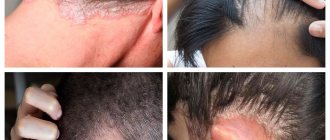

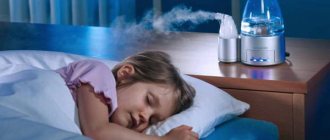

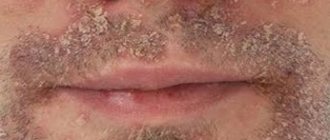
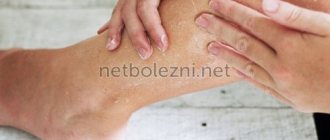
![Table 2. Glucocorticosteroid preparations for local use in the treatment of rhinitis [7, 8] Table 2. Topical corticosteroids for rhinitis [7, 8]](https://dlradio.ru/wp-content/uploads/tablica-2-preparaty-glyukokortikosteroidov-dlya-mestnogo-primeneniya-pri-lechenii-rinita-330x140.jpg)
